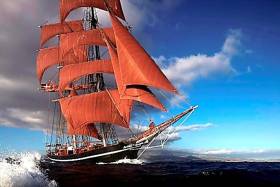Displaying items by tag: Eye of the Wind
Tall Ship 'Eye of the Wind' Is Ireland-Bound
#TallShips - A legendary tall ship that's featured in Hollywood movies such as White Squall and The Blue Lagoon will visit Dublin next month for the first time in 20 years.
Eye of the Wind was first built in 1911 under the name Friedrich as a cargo vessel, but the brig began its 'second maiden voyage' under its current name in 1976 after extensive renovations by a British sailing enthusiast.
Since then it's had many adventures on the high seas besides its silver screen appearances, including being the flagship for the scientific expedition 'Operation Drake' in 1978, where even patron Prince Charles took the helm for a spell.
These days, however, the distinctive tall ship rounds the world as a sail training vessel for young people aged 16 to 25, captained for the last seven years by Swiss skipper Cornel Greth - who's determined to make new memories for this more than a century old shining example of sailing history.
“Before 2009, the Eye of the Wind sailed under various owners,” he says. “That’s why there is no complete documentation of all past trips recorded in our logbooks.
"We assume that the last voyage to Dublin dates back to 1996, when the crew at that time sailed from Bristol to the '50 Years of the Irish Navy' weekend.
"Certainly the forthcoming journey to the coast of Éire must be the first one of its kind in nearly two decades.”
Eye of the Wind is set to arrive in Dublin on Wednesday 5 October after a one-week crossing of the Irish Sea from Oban in Scotland. Following a two-day stopover, the captain and trainee crew will sail on to the Netherlands, Spain and the Canary Islands.
For more details see www.eyeofthewind.net





























































